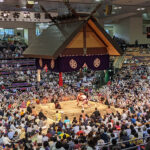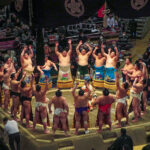If you want to enjoy a sumo tournament to the fullest, it’s helpful to know a few of the key sumo rituals that take place during the event. Sumo is rich in tradition, and understanding these rituals will enhance your experience.
1. Yobidashi (呼出し) – Wrestler Announcement
The yobidashi are the announcers of the sumo world, responsible for calling each wrestler to the ring before a match. Dressed traditionally, they call out the wrestlers’ names in a unique, drawn-out chant that fills the arena. This call signals that the match is about to begin, adding a layer of anticipation as the audience awaits the upcoming bout.


2. Dohyo-iri (土俵入り) – Ring Entering Ceremonies
The dohyo-iri is a ceremonial ring-entering ritual that showcases each wrestler from Juryo (the second division) and Makuuchi (the top division). Wrestlers enter the ring in elaborate, colorful aprons called kesho-mawashi, each uniquely designed. Higher-ranked wrestlers perform special movements to purify the ring, a ritual that dates back centuries and symbolizes respect for the spiritual aspect of sumo.



3. Shiko (四股) – Foot Stomping
Shiko, or the dramatic foot-stomping exercise, is one of sumo’s most iconic sights. Wrestlers lift each leg high and bring it down with force, symbolically stamping out evil spirits from the ring. It’s an impressive display of balance and strength that serves as both a warm-up and a spiritual cleansing.


4. Shubun (守護) – Salt Throwing
Salt throwing is a common ritual in sumo, where wrestlers toss handfuls of salt into the ring before each match. This act is meant to purify the ring and drive away any negative energy. You’ll notice that some wrestlers throw larger amounts of salt, while others take a more modest approach—it’s a personal ritual that each wrestler performs in their own style.

5. Chikara-mizu(力水)– Water Break
Before a match, each wrestler takes a sip of chikara-mizu, or “power water,” provided by a fellow wrestler. This simple yet symbolic gesture represents purification and focuses the wrestler’s energy. It’s a small but significant act that helps them prepare mentally and spiritually before entering the ring.

6. Chirichozu (塵手水) – Hand Clapping
In the chirichozu ritual, wrestlers clap their hands together as they face each other, calling the gods to witness the match. This gesture is a nod to Shinto beliefs, inviting divine attention to ensure fairness and honor in the upcoming contest. It’s one of the many ways sumo embodies respect and spirituality.

7. Shikiri (仕切り) – Pre-Match Stare Down
The shikiri, or stare-down, is an intense moment before the match begins. Wrestlers crouch opposite each other, locking eyes and testing each other’s mental fortitude. This ritual builds suspense, and while it may seem like a psychological battle, it also allows each wrestler to strategize and focus their energy.

8. Tachiai (立合い) – Initial Charge
The tachiai is the thrilling initial charge that launches each sumo match. Both wrestlers propel themselves forward with incredible force, engaging in an explosive collision that sets the tone for the bout. The tachiai often determines the direction of the match, making it a crucial and exciting moment.

9. Jōno-naoshi (塩の直し) – Post-Match Ritual
After the match, wrestlers take a moment to collect themselves and return to their starting positions. They perform a brief ritual that includes scattering a bit more salt in the ring, a final act of respect for the ring and the spirits. It marks the end of their performance and a return to calm, reinforcing the sport’s dignified traditions.
After a bout where there are kensho (sponsor) banners presented, the winning wrestler receives envelopes containing prize money. The sum for each banner is around 60,000 yen, with about half going to the wrestler and the remainder allocated to various fees. This ritual of receiving prize money is typically done with humility, as the victorious wrestler bows and accepts the envelopes from the referee before quietly returning to the locker room.


10. Monoii (物言い) – Judges’ Conference
In close matches, the monoii ritual occurs when judges gather to discuss the result. The head judge and ringside officials confer to ensure a fair outcome, and if necessary, they’ll review the footage to make the final call. The monoii highlights the dedication to accuracy and honor in sumo, making sure each match is decided justly.

Experiencing a sumo tournament isn’t just about watching a physical competition—it’s a journey into the heart of Japanese culture and tradition. Each ritual, from the solemnity of the ring-entering ceremony to the intense stare-downs and even the discreet acceptance of prize money, speaks to the respect and reverence that sumo wrestlers have for their craft.
By understanding these customs, you gain a deeper appreciation for the honor and spirituality woven into each match. Sumo isn’t merely a sport; it’s a living heritage that continues to captivate and inspire fans from Japan and beyond.



